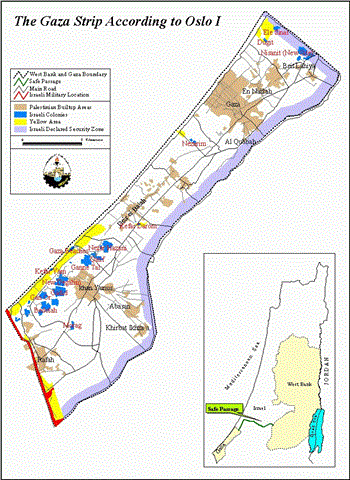The Gaza Strip has long suffered from the scarcity of natural resource especially water and land. The residents of the Strip depend on rain and the water aquifer to secure their daily intake of water for household, agricultural, and industrial uses. The increase of the number of users, the large population density, in addition to the existence of Israeli settlements atop the aquifer in the north and the south of the Strip has imposed a great deal of pressure and strain on this finite resource.
Most of the studies conducted dealing with the issue of water situation in the Strip details the problems and the dangers surrounding the ability of the Strip to meet its daily water intake. One of such studies was conducted by the World Bank back in 1996 and it concluded that pumping water from the aquifer at the indicated rate in the study would deem the water unhealthy for human consumption in the short run. It also indicated that the aquifer would be all used up in less than 20 years.
The Israeli occupation of the Gaza Strip since 1967 made the water situation in the Strip even more delicate and fragile as occupation forces implemented a number of policies aimed at robbing the Strip of its natural resources in an attempt to serve its own illegal colonial population. Such policies can be summarized in the following points:
-
Issuing a number of military orders limiting the amount of water a Palestinian can extract in addition to refraining from issuing licenses to dig new wells.
-
The confiscation of Palestinian lands located directly atop the aquifer in the north and the south of the Strip. These lands were later used for Israeli settlement construction.
-
The pumping of a great percentage of the water in the Gush Qatif settlement block and then transporting the water to the Negev to be used by the Jewish population there.
Yet, and despite the illegality of these Israeli practices, Israel insists that such practices lies within its jurisdiction, according to Israeli water expert Elish'a Kali. His proposed ''solution'' for this problem is for Egypt to include Gaza in its Sinai watering plans (!!) forgetting, in the process, that the actual solution would be for Israel to stop depleting and outstripping Gaza of its natural resources.
The Gaza Water in the Palestinian-Israeli Agreements:
The Cairo Agreement dealt with the issue of water in the Gaza Strip as explained in Appendix II, Article II, Point 31. Yet, and despite the fact that this Agreement was unjust for Palestinians, Israel renegaded on its duties according to the Agreement; Israel was obliged to provide the Palestinian Authority with detailed information about the wells located in the Israeli settlements in the Strip in addition to the type and quantity of the water pumped on monthly basis. Not only did Israel fail to honor that commitment, it continued to over-pump water from the aquifer in addition to keeping the monopoly that Israel's Makorot Water Company has in the area, an act in itself is considered as a gross violation of Palestinian water rights. Ignoring this Agreement, Israel appears adamant to carry out its colonial master plans that call for the absorption of more Palestinian lands and resources and using them to sustain a Jewish colonial presence on Palestinian soil.
Israeli Violation of Gaza Waters since Intifadat Al Aqsa:
Since the inception of Intifadat Al Aqsa on the 29th of September 2001, Israeli forces and settlers began the execution of a brutal campaign against Palestinians and their possessions especially in the land and agriculture sectors; earlier reports indicated that Israeli occupation forces have razed and bulldozed more than 7000 dunums in Gaza up until the end of February 2001. One of the main targets of this campaign were the Gazan water wells as more than 100 wells used for the irrigation of 10,000 dunums were demolished. Such wells were considered to be the best in Gaza, in terms of water quality, as most of them were located in the perimeters of Israeli settlements in the Strip. It is believed that such demolishing activities are part of a larger Israeli pre-programmed scheme aiming at:
-
The complete and total acquisition of water resources in the Strip,
-
The prevention of water access by Palestinians,
-
The stealing of more water quantities that can be used by Israeli settlers,
-
The creation of more than 10,000 barren dunums that can not be re-planted due to the demolishing of the water sources, the rehabilitation of which is unlikely in the short or the long run,
-
The prevention of Palestinian access to some 7,000 dunums, which blocks its cultivation and what that means in terms of economical loss incurred by the Palestinian economy, in addition to
-
The obstruction of Palestinian access to the low-sodium water that can be used to grow crops that are competing against Israeli products such as strawberries and flowers.
Prepared by
The Land Research Center
LRC














